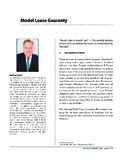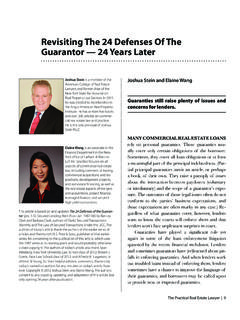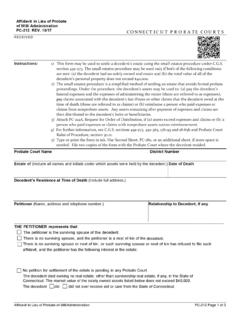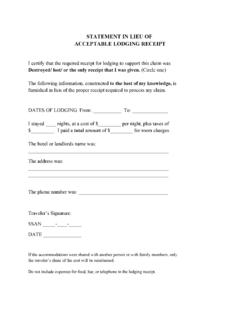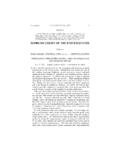Transcription of DEED IN LIEU OF FORECLOSURE AGREEMENT - …
1 NY\ DEED IN lieu OF FORECLOSURE AGREEMENT JOSHUA STEIN1 Sometimes both the borrower and the lender guess wrong about a mortgaged property. Instead of maintaining or increasing its value, the mortgaged property might lose value, because of bad management, bad neighborhood trends, a bad local economy, bad luck, or a correction of previous market-wide overpricing of real estate assets. When bad things happen to mortgaged property, a typical nonrecourse loan always gives the borrower the option to walk away from it. The borrower can let the lender foreclose and take the mortgaged property, but the lender will have no right to chase the borrower if the value of the mortgaged property won t cover the entire loan.
2 If a borrower has resigned itself to losing the mortgaged property and wants to maintain its reputation with this lender and others, the borrower will often not force the lender to go to the trouble of holding a FORECLOSURE sale. Instead, the borrower will simply deed the mortgaged property to the lender or the lender s designee, saving all parties the time, trouble, expense, and bad publicity of a FORECLOSURE action. A transaction of this type, a deed in lieu of FORECLOSURE , formalizes the borrower s exercise of its option to walk away from a bad investment. The borrower recognizes that it has lost its equity investment in the mortgaged property.
3 Although the borrower might have an opportunity to leverage the lender by taking advantage of the delays and uncertainties of the FORECLOSURE process, the borrower declines to do so. Instead, the borrower makes life (or at least the transfer of the mortgaged property) easy for the lender. A borrower that walks away gracefully will often find that the same lender that took back an unsuccessful investment will happily do business with the same borrower again on another property. Nonrecourse lenders recognize that taking back bad investments is part of the risk they ve agreed to assume.
4 They can t necessarily complain when the risk actually hits. For any deed in lieu of FORECLOSURE transaction, both borrower and lender often want to memorialize the circumstances of the borrower s abandonment of the mortgaged property. And a lender fears that after the transfer the borrower will somehow try to undo it a risk that the lender can mitigate by obtaining certain assurances from the borrower. For these reasons, a borrower and a lender that consummate a deed in lieu of FORECLOSURE will often enter into a deed in lieu of FORECLOSURE AGREEMENT . Here, the borrower will acknowledge some factual matters about the mortgaged property and the transaction, and the lender will confirm that the borrower has no liability for the loan or most other obligations under the loan documents.
5 1 This article is based on a chapter in LENDER S GUIDE TO STRUCTURING AND CLOSING COMMERCIAL MORTGAGE LOANS (Mortgage Bankers Association 2004). Copyright (C) 2008 Joshua Stein ( ). Please forward any comments to the author at 2 NY\ This Chapter offers a sample deed in lieu of FORECLOSURE AGREEMENT , with some exhibits for typical closing documents to further implement the transaction. (Some of those exhibits can be used on their own -- without the deed in lieu of FORECLOSURE AGREEMENT -- where the legalities and circumstances justify it.)
6 This deed in lieu of FORECLOSURE AGREEMENT raises a variety of substantive legal issues, including the following. 1. Mezzanine Lender. If a transaction also involves a mezzanine lender, the mortgage lender probably entered into an intercreditor AGREEMENT that would prevent the mortgage lender from accepting a deed in lieu of FORECLOSURE without first giving the mezzanine lender certain notices and an opportunity to cure the borrower s default. Any mortgage lender should comply with these requirements. Going beyond those requirements, a mortgage lender will often be well advised to try to persuade the mezzanine lender to acquire the mortgage loan, perhaps even at a discount.
7 The mezzanine lender offers the single easiest and most attractive exit opportunity for any defaulted mortgage loan. 2. Tax Planning. The borrower may suffer recapture income from a deed in lieu of FORECLOSURE , and should consider this issue early in the process of negotiating a deed in lieu of FORECLOSURE . Borrowers often use the following techniques, and others, to avoid recapture income: (a) retain some very small interest in the property for a year or two notwithstanding the deed in lieu of FORECLOSURE ; (b) close the conveyance as a tax-free exchange; or (c) retain bare title to the mortgaged property for a certain period, under an arrangement that gives the lender total control over the mortgaged property, all its income, and the right to resell it.
8 These transactions take time to structure and document. 3. Disclosed Liabilities. In the months before a borrower loses a mortgaged property in FORECLOSURE (or through a deed in lieu of FORECLOSURE ), the borrower will typically fall behind in paying real estate taxes and operating expenses. To some degree or another, depending on the circumstances, the resulting mess will belong to the lender after the borrower loses the mortgaged property. If a lender has significant leverage (for example, because the lender can show the borrower and its principals may have incurred recourse liability during the collapse and fall of the mortgaged property), then the lender may be able to convince the borrower to bring current all liabilities for the mortgaged property.
9 In the more typical case, the borrower will simply want to walk away and insist on doing so as the price of not forcing the lender to go through the FORECLOSURE process. In these cases, the best the lender can do will be to obtain some representations and warranties from the borrower and its principals about the scope of any continuing liabilities and claims. To deal with that typical set of facts, this deed in lieu of FORECLOSURE AGREEMENT sets up a definition of Disclosed Liabilities, and contains the lender s commitment not to chase the borrower to pay any of these items. On the other hand, this model does not obligate the lender to pay the Disclosed Liabilities after closing, but does include a vague commitment to consider paying them if appropriate.
10 The borrower may ask for more, to protect itself from claims and litigation after the closing. How this issue turns out depends entirely on the parties relative leverage under the circumstances, and the wording and scope of the nonrecourse clause in the loan documents. 3 NY\ 4. Deed in Escrow. A deed in lieu of FORECLOSURE should not be confused with a deed in escrow. The latter transaction contemplates that the parties remain borrower and lender, the borrower continues to own the mortgaged property, and if the borrower ever misbehaves again the lender can simply release and record the deed in escrow.
